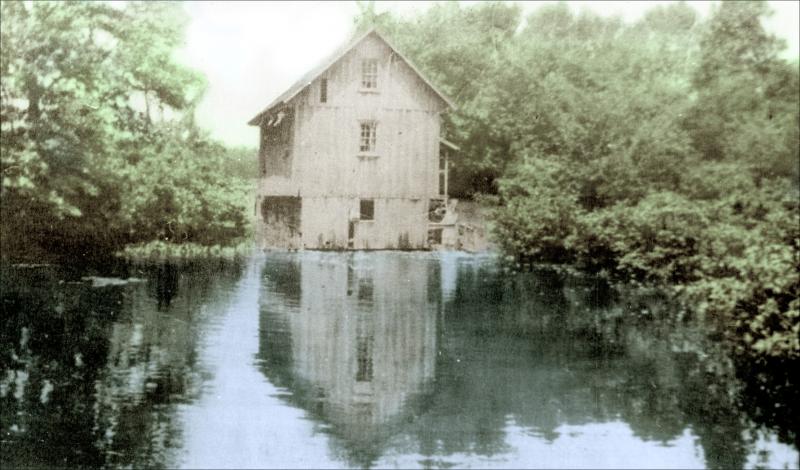TO GRIND THE GRAIN IN DUE COURSE AS IT IS BROUGHT HITHER
HISTORY OF CAPE HENLOPEN AND BEYOND
GOSLEE MILL POND
Scharf's History of Delaware gives the first history of Goslee Mill Pond. On page 1218 he writes “On the 4th of March, 1695, the court at Lewes was petitioned by Jonathan Bailey to grant him part of the branch formerly called Bundick's on which to build a water mill. The court granted the request, on condition that he would ‘build the mill within fifteen months, and to attend and mind the same and grind the grain well and in due course as it is brought thither without respect of persons, at the eight-part toll for wheat and sixth part toll for Indian corn.” The only mill successfully operated in the hundred in 1887, was the small grist mill of Benjamin burton at the head of Love Creek, where a mill had been maintained for more than a century and a half.”
It is recorded in the Hall of Records in Dover that Benjamin Burton owned two mills, known as the upper mill and the lower mill, the lower mill probably being the one in Angola. For several years the upper mill, (our mill) was operated for Mr. Burton by a man named Goslee, and so, it gradually became known as Goslee's Mill, probably to differentiate between the two mills. Sometimes it has been called Gosling's Mill.
This mill was purchased from the Burton heirs by my father, James H. Hurley, of Georgetown m Delaware, who operated the business from 1904 until around 1920 when it became unprofitable. In 1905 he had married Maude Coverdale, who was born and raised on a nearby farm ( now the Mahlon Graves Farm). I can remember that she learned to operate the mill when it was necessary. The building was demolished in 1934 because it was run down, falling apart and unsightly.
After father discontinued operation of the mill he started a small grocery store near the mill site. After his death in 1929, mother operated the store until 1968 when she was 88 years old. She had remarried in 1932 to Stephen H. Warrington of Georgetown, Delaware and continued with the store even after his death in 1950. Mother passed away on February 8, 1978, at 9 years of age.
The mill site and pond area continue to be a peaceful and unspoiled spot. It is, I think unpolluted, and I would like to see it preserved in its natural state as a wildlife refuge for future generations to observe.
Clarence Wall, born and raised on the farm next to the mill can remember how the mill operated and is working on plans for a replica.
The location site is on the old Lewes to Millsboro Road known as Robinsonville Road which crosses the head of love Creek, the steam that separates Lewes-Rehoboth Hundred and Indian River Hundred. Where the Bundick and Love Creek branches merged, a dirt dam about 300 feet in length was constructed. The labor was furnished by men using oxen and carts to haul dirt from a site nearby, spoken of in my deed as the 'dirt hole'. This excavation can still be seen. The dam is still intact although the spillway has broken out and there is no way to keep the water level high.
In the early 1900s, Gypsies came during the fall to camp at the 'dirt hole' for about a month or three weeks and so the area became known as “Gypsies Landing”. There they had fresh water from the pond, protection from the winds in the lee of the day hour and shelter with the trees. They came by horse and wagon, prhaps a dozen or more, with extra horses. A jolly and happy band of prople, they dessed in right colorful clothing, sang and danced at night by firelight. They made a living by telling fortunes and trading, even horses. The Gypsies made their annual visits in the area until probably around 1915.
Parallel with the bridge was an auxiliary crossing through the water which was used to water horse teams and to swell the wooden wagon wheels to make them fit more securely to their iron rims.
The general area is now beginning to be known as Rabbits Ferry, that name being traced back to the two schoolhouses known by that name , one building serving as the white children s school and another for the colored children The white childcare’s school, was a one room building, #89, built one mile southwest of Bundicks Branch, head water to Goslee Pond on a road now known as Beaver Dam Road, at an intersection with Kendele Road. The school was painted red and called Rabbits Ferry Little Red School.
Many people have asked about the origin of the name Rabbits Ferry and this is the story I was told;
“The school being built by community residents, volunteering their time and skill, as the building was going up, wives came to bring dinner, they would spread a cloth on the ground, and while they were eating, a rabbit ran out of the wood nearby, straight across their picnic meal. Causing much confusion and laughter, they yelled out, 'a rabbit has ferried across our dinner'! Hence the name Rabbits Ferry School.
The Rabbit's Ferry white school was bought by Lacey Johnson, who was born and raised in the area, moved and renovated into his present home. The colored school building was bought by George and Rosie Johnson, also natives of the area moved and renovated into their home.






















































